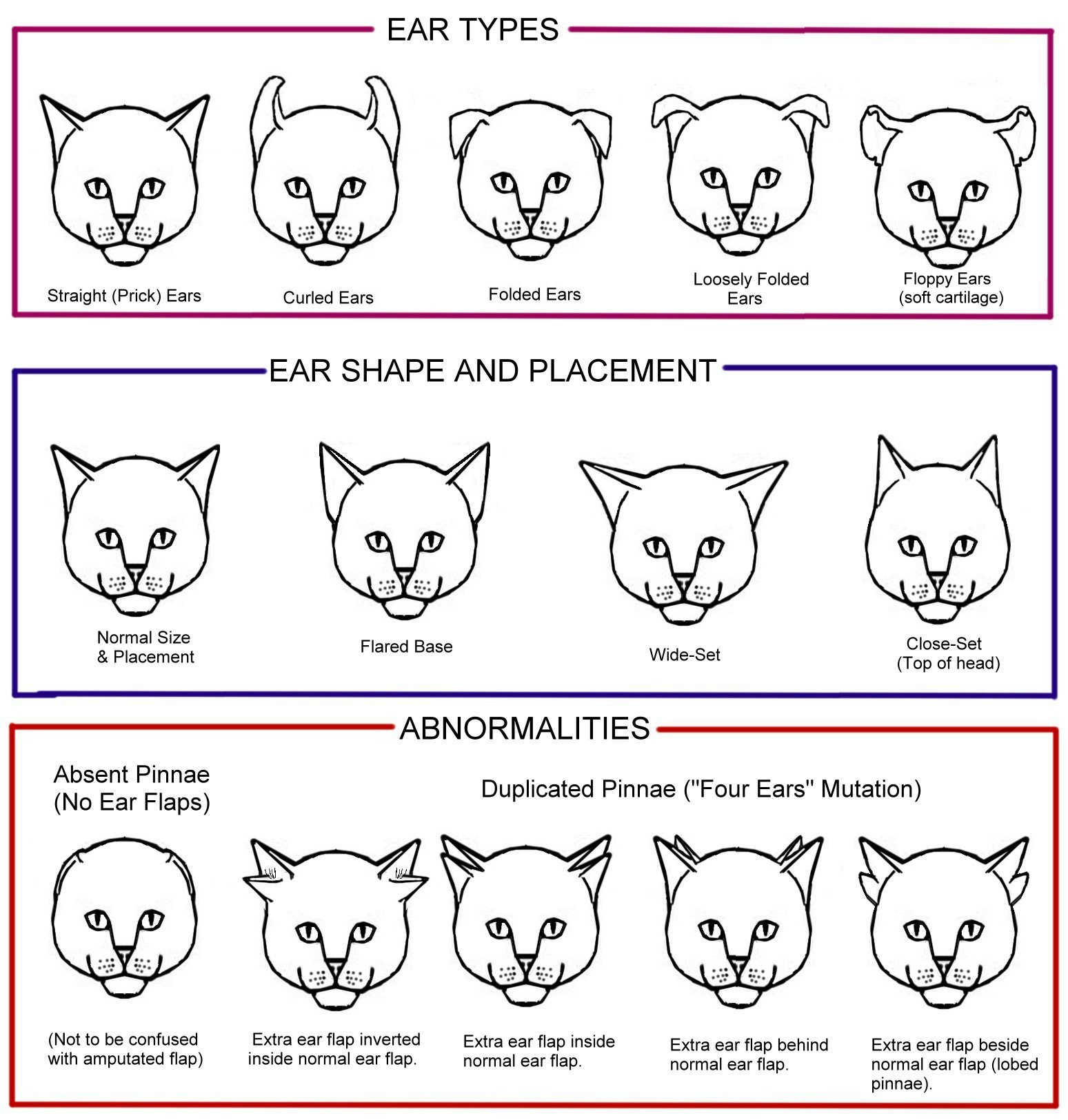
CURLED, CURVED AND FOLDED EAR CATS
Cats generally have prick (upright ears) which are triangular in shape. The size, set and exact shape varies from the small ears of Persian cats to the "bat-like" flared ears of some Siamese cats. Some breeds require the base to be more widely flared than others. Some breeds have ears placed close together high on the head, others have wide-set ears with a broad expanse of forehead between. The tips may be rounded, pointed, tufted or fringed depending on the breed.
There is also a rare genetic condition causing the cat to have a second, smaller, pair of ears behind the normal ears. These are apparently non-functional and may be no more than ear flaps with no middle or inner ear section. Though affected cats are generally physically healthy, some have reportedly been lethargic or sluggish which suggests that the condition might affect the brain. This rare condition must not be confused with accounts of "four-eared cats" from China - these were Persian-type cats where the fur inside the ear gave the impression of extra ear-flaps.

In addition to variations on a general theme, there are two distinct ear shapes - folded forwards and curved backwards. Both mutations (or very similar mutations) have occurred more than once.
FOLDED EARS
The Sumxu (Chinese Lop) is now regarded as extinct, but was once found in the area around Peking, China. Descriptions of the Sumxu as longhaired cats with glossy black or yellow coats and pendulous ears derive from a series of mistranslations and the confusion of two entirely different animals! A Polish Jesuit missionary to south China, Michael Boym (ca. 1612-1659), first described the Sumxu in his illustrated book Flora Sinensis (1656) in which he also described Chinese fauna. "Sum Xu" was the Portuguese rendering of songshu, meaning "pine rat". Though Boym's illustration resembles a squirrel, the description indicates the Yellow Throated Marten (Martes flavigula) found in the region. Boym wrote that the Sumxu was a pretty yellow-and-black animal that was commonly tamed and wore a silver collar. They were valued as hunters of mice and sold for up to 9 silver coins (indicating their usefulness or rarity).
The cat-like Sumxu was described in early 1700s as a curiosity, and in 1796 when a droop-eared cat brought back from China. But how did the Sumxu name end up attached to a variety of cat?
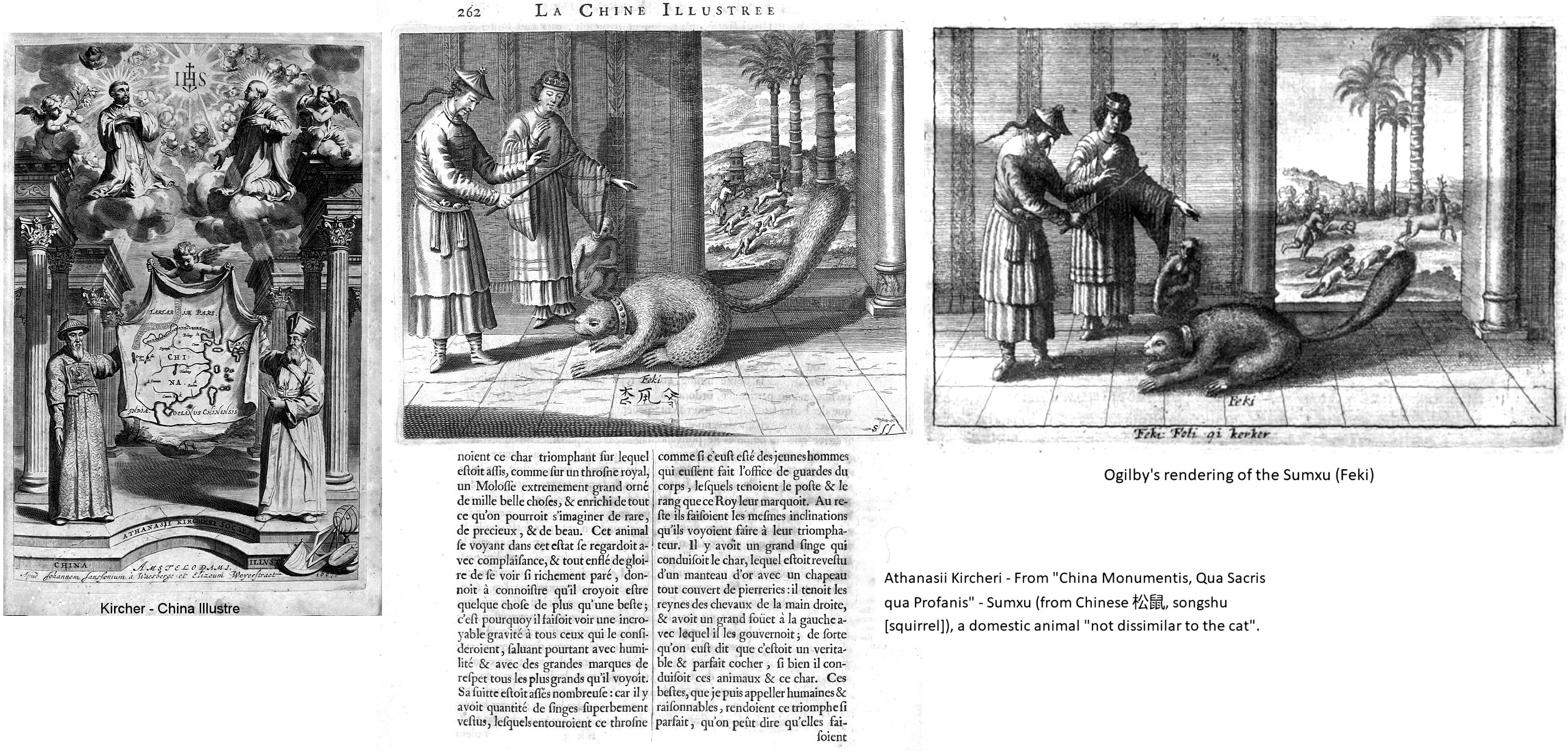
This engraving is from German Jesuit Athanasius Kircher's book "China Monumentis, Qua Sacris qua Profanis" (1666). The book is written in Latin and describes the Sumxu as being like a cat. The engravings would have been done from descriptions or rough sketches rather than from life. Kircher was a scholar rather than a missionary and he relied on the expert knowledge of those who had travelled to China, such as Boym and one of Kircher's former students, Martino Martini. Kircher's description of the sumxu referred to it as a domestic animal similar to a cat (in Europe, martens were also known as "tree cats"). He described it as black and saffron coloured with splendid hair. Following Boym's description, Kircher also mentioned that the Chinese tamed this creature and put a silver collar around its neck. It was an avid hunter of mice and was rare and valuable. The creature depicted, while similar to Boym's illustration, was the size of a small bear and is shown chasing deer, rather than mice! In this it resembles a wolverine, rather than a marten.
Italian Jesuit Martino Martini had visited China in the 1650s and published Novus Atlas Sinensis in 1655. In the section on Peking Province, Martini described a race of white, long-haired and long-eared cats found in the region. He wrote that the cats in that province were white all over with long hair and long ears like lap-dogs and that these well-fed cats did not catch mice, but were ladies' lap-cats. Martini became the definitive source of information about China and his description was used in 1673 by John Ogilby and by others who described the long-eared, milk-white cats as being companions and not hunters (there being other cats that were good mousers). The cats were likened to the Maltese lap-dog and to spaniels. It retrospect, it is likely that these white cats were also blue-eyed, a combination of traits associated with deafness in cats - quite likely they couldn't hear the mice in order to investigate mouse bolt-holes! If this was the same mutation as the Scottish Fold, it is associated with sometimes crippling changes to the tail, hind legs and vertebrae which would make an affected cat reluctant to move around.
In 1736-37, Martini's work was superseded by that of French Jesuit du Halde's works on the Chinese Empire. This compiled material from French Jesuits and re-used some of Martini's book, including the description of the long-eared white cats: "Among the animal species one finds singular (i.e. unique) cats which the Chinese ladies seek out to provide them with amusement and feed with plenty of delicacies: they have long fur and drooping ears." This remained the standard reference book for many years and was reused by other authors, including the passage about the lop-eared cats. For example John Green's book described the lop-eared cats of Peking Province as "a particular Sort of Cats, with long Hair, and hanging Ears, which the Chinese Ladies are very fond of." This was later translated back into French by abb Prev t as "among the animals one finds a singular species of long-haired cats with hanging ears, which the Chinese ladies greatly liked."
In volume 4 of his "Histoire Naturelle" (?1767), Georges Louis Leclerc, Comte de Buffon, wrote "The Natural History of The Cat". Buffon noticed that, unlike the many breeds of dog, there were few distinct races of domestic cat: Spanish, Syrian and Khorasan (Persian). He believed the long-haired lop-eared Chinese cat could be a fourth distinct type. "They (cats) are in nature much more constant, and their domesticity is not as complete nor as universal as that of the dog, so it is not surprising they are less varied in type. Our domestic cats, though different from each other in colour, do not form distinct and separate races. Only the climates of Spain, Syria or Chorazan (Persia) have produced constant varieties; to find another, one must join the climate of the province of Pe-chi-ly (Northern Zhili) where there are cats with long hair and hanging ears, much liked by the Chinese ladies." Buffon was translated into English in 1781 by William Smellie. According to Buffon, "Our domestic cats, though they differ in colour, form no distinct races. The climates of Spain and Syria have alone produced permanent varieties: To these may be added the climate of Pe-chi-ly in China, where the cats have long hair and pendulous ears, and are the favourites of the ladies. These domestic cats with pendulous ears, of which we have full descriptions, are still farther removed from the wild and primitive race, than those whose ears are erect."
In a supplement, Buffon added that there was some doubt as to whether the Sumxu was a cat or some other animal: "I formerly remarked, that, in China, there were cats with pendulous ears. This variety is not found any where else, and perhaps it is an animal of a different species; for travellers, when mentioning an animal called Sumxu, which is entirely domestic, say, that they can compare it to nothing but the cat, with which it has a great resemblance. Its colour is black or yellow, and its hair very bright and glittering. The Chinese put silver collars about the necks of these animals, and render them extremely familiar. As they are not common, they give a high price, both on account of their beauty, and because they destroy rats."
Buffon's source was Prevot, whose source was Green, whose source was de Halde, whose source was Martini's 1655 work. Buffon noticed a process we now call neoteny - domesticated animals retain juvenile features into adulthood. Thus wolves ahd pricked ears and domestic dogs often had softer, hanging ears. Buffon believed this could apply to cats as well and that the mild climate and ancient civilisation of China was conducive to domestic cats developing a similar trait to domestic dogs. In his work, Buffon also mentioned the sumxu as a pretty domestic animal of China, not unlike a cat. In his Vol VIII (published 1777), Buffon goes so far as to suggest the lop-eared cat of China is a different species from the ordinary domestic cat and that it might therefore be the cat-like sumxu:
"We said (volume VI, page 14) that China has a race of cats with hanging ears; perhaps this variety is found nowhere else and is a species to the (domestic) cat, because Travellers speak of an animal called the Sumxu, which is completely domestic in China and which is in many respects like a cat. In colour it is black and yellow with extremely glossy fur. The Chinese give them silver collars around their necks and make them very tame. As they are uncommon, they are expensive; not only because of their beauty, but because they most cruelly wage war upon rats."
This seems a big leap (and an erroneous one) from Boym's black-and-yellow squirrel-like creature to Martini's white lop-eared cat, however du Halde had omitted to mention in his compilation that the lop-eared cats were milk-white! While Boym's sumxu was valued as an avid mouser, Martini's lop-eared white cats were not interested in mice and were kept as lap-cats, another piece of information du Halde omitted in his compilation. Boym's illustration of the sumxu ignores its ears, while Martini described them as the defining feature of the white cats. Boym didn't liken the sumxu to cats and it is Kircher who made that comparison. The sumxu (probably the Yellow Throated Marten) was a creature of south China while the lop-eared cats were from Peking Province in the north. Buffon's leap was further misinterpreted by later authors such as French writer Anselme Ga tan Desmarest who combined the name "sumxu" with the description of the lop-eared cat (its white colour being unknown to him) as "hanging-ear cat, fur long and fine, black or yellow, domesticated in China in Peking province (Pe-chi-ly) under the name of sumxu". This was perpetuated through the 19th and early 20th centuries, especially by cat fanciers looking for new and exotic cats to import.
When China reopened to foreigners after the Opium Wars, a number of missionaries, entrepreneurs, cat fanciers and researchers went looking in vain for the lop-eared cat. In his book "Variation of Animals and Plants Under Domestication" Charles Darwin referred briefly to a drooping eared race of cats in China. In "The Cat" by Lady Cust (1870) it states "Bosman relates that in the province of Pe-chily, in China, there are cats with long hair and drooping ears, which are in great favour with the Chinese ladies; others say this is not a cat but an animal called 'Samxces'"
In his 1885 book "The Cat: Natural History, Husbandry ["Hygiene"] and Illnesses" Gaston Percheron suggested the lop-eared cat might be a hybrid between the cat and a marten: "Certain respected naturalists even claim even that the [domestic cat] mates with the marten and produces among the hybrids those like the latter in colour and fur. In this way they explain the hanging-ear cats of China [...]" but instead of being fed delicacies by its mistress, the cat has become a delicacy to be eaten, "The Chinese Cat. It has long, silky hair and hanging ears, like those of a badger. Its flesh is highly esteemed by the inhabitants of the Celestial Empire. As with the dog, it is treated with great solicitude by feeders and fatteners of this country and when it is fattened, it appears alongside swallows' nests on well-served tables. " As a side-note, in 1926, Siamese cat fancier Lilian J Veley remained adamant that Siamese cats were not merely a form of domestic cat, but resembled an unknown type of viverrine that lived in the region (the most likely contender again being the Yellow Throated Marten) in their sable-and-dun colour and "marten-like" face! Maybe "Sumxu" and "Siam" sounded similar to her ears.
The Chinese, or Hanging Ear, Cat according to "Die Hauskatze, ihre Rassen und Variet ten" (Housecats, Their Races and Varieties) from "Illustriertes Katzenbuch" (An Illustrated Book of Cats) written and illustrated by Jean Bungartz, published in Berlin in 1896 (There is no published English translation of this book, this gives the gist of the text)
The Chinese or Hanging-Ear cat is most interesting, because it provides proof that by continual disuse of an organ, the organ atrophies. So with the Chinese cat the hearing and/or the ears have deteriorated. Michel says the Chinese, not only admire the cat in porcelain, but also value it for culinary reasons. The cats are regarded as special titbits and enjoyed particularly with chains (noodles?), with rice". This cat is bred particularly for the purpose of meat production, and is a preferred Chinese titbit; this is not unusual if one considers that the Chinese consume much the sight of which turns the stomachs of Europeans. The poor creature is locked up in small bamboo cages and much like a kind of geese fattened with plentiful portions. Extensive trade is carried on with other parts of Asia and the Chinese allow no tomcats to be exported so there is no interference in this lucrative source of income.
Due to the restrictive conditions that have deprived the cat of its actual use, its hearing decreased because it was no longer needed as for hunting its own food. With no need for watchfulness, it was useless to have sharp hearing to listen for hidden things so the hearing became blunt and in natural consequence the ear lost its upright nature, gradually become lower and becoming the hanging ear that is the characteristic feature of the Chinese cat. At first impression this is a surprising and amusing look, but is impression is lost with closer examination. If one ignores the characteristic of the ears, one sees a beauty similar to the Angora cat: a long, close coat of hair, albeit less rich, covers the body. The hair is silky-soft and shining and the colour is usually a light yellow (isabelline) or a dirty white yellow, although some have the usual colouring of the common house-cat. In size it considerably exceeds house-cats and is stronger. The ears hang completely, as with our hunting dogs and are large in relation to cats.
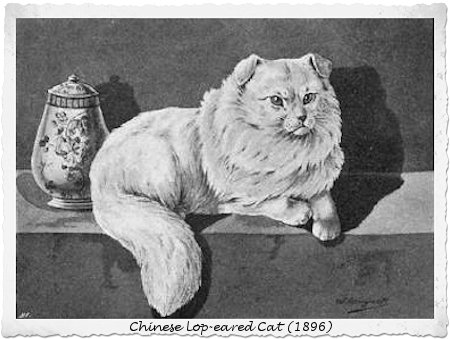
Although the Chinese cat is found in considerable numbers in its homeland, it rarely arrives at European animal markets. Only one such cat has reached us in the flesh; we acquired this years ago when a sailor returning from China brought it into Hamburg. The accompanying illustration is based on this. In character it is like the Angora cat and somewhat inactive. It also prefer to live by a warm fire, is a little sensitive to attention, hears badly and is at its most animated when it sees the milk or food. Apart from its unusual ears, it does not have any really attractive characteristics and is a strange representative of the house cat.
Though reports refer to the Chinese Lop having pendent or pendulous ears (suggesting abnormally long or floppy ears e.g. like a labrador dog) this is probably an exaggeration. In all likelihood, and in the absence of any current examples or pictorial evidence, the ears were folded in a manner similar to the Scottish Fold. In Frances Simpson's "The Book of the Cat" (1903), contributor H C Brooke wrote "There is said to be a variety of Chinese cat which is remarkable for its pendent ears. We have never been able to ascertain anything definite with regard to this variety. Some years back a class was provided for them at a certain Continental cat show, and we went across in the hope of seeing, and if possible acquiring, some specimens; but alas the class was empty! We have seen a stuffed specimen in a Continental museum, which was a half long-haired cat, the ears being pendent down the sides of the head instead of erect; but do not attach much value to this."
In 1926, Brooke wrote that "for donkey's years" Continental cat shows had offered prizes for the Drop-eared Chinese Cat. On each occasion, the cat failed to materialise and Brooke considered it to be mythical. Other writers suggested it was the result of haematomas causing the ears to fold or crumple. Brooke noted that although no-one ever saw the cat itself, one always met "someone who knows someone whose friends has often seen them". He had been assured by a Chinese gentleman he had met only once that "he knew them well". HC Brooke, and other fanciers, made enquiries of the Chinese Embassy, of Hagenbeck's (a major Hamburg animal dealer at the time) and of a "certain well known author, who has lived for years in China and knows that country well", but to no avail. The American Express Company had instructed their representatives at Shanghai and Peking to make enquiries, again without success. None of the wild animal dealers knew of the Chinese Lop.
The German naturalist, Brehm, had given a very detailed description of the cat in the 1700s. Brehm was usually very accurate. In 1882, Brooke had seen a stuffed specimen in a Continental museum. The specimen was "half-coated with yellowish fur". He admitted that it might have been a fake or a cat with its ears deformed by canker (i.e. cauliflower ears) that had been presented in all good faith. All avenues of enquiry exhausted, Brooke declared the Chinese Drop-eared cat extinct. The last reported sighting of the Chinese Lop seems to have been in 1938 when a droop-eared cat was imported from China. On that last occasion the mutation was thought to be restricted to white longhaired cats. It is hard say for certain whether these were isolated cases or whether the Chinese Lop was a genuine variety. It cannot even be said with certainty that the trait was an inherited one.
Cats with folded ears have been reported in the Hebrides, Germany and Belgium, but were apparently regarded as no more than isolated curiosities and not bred.
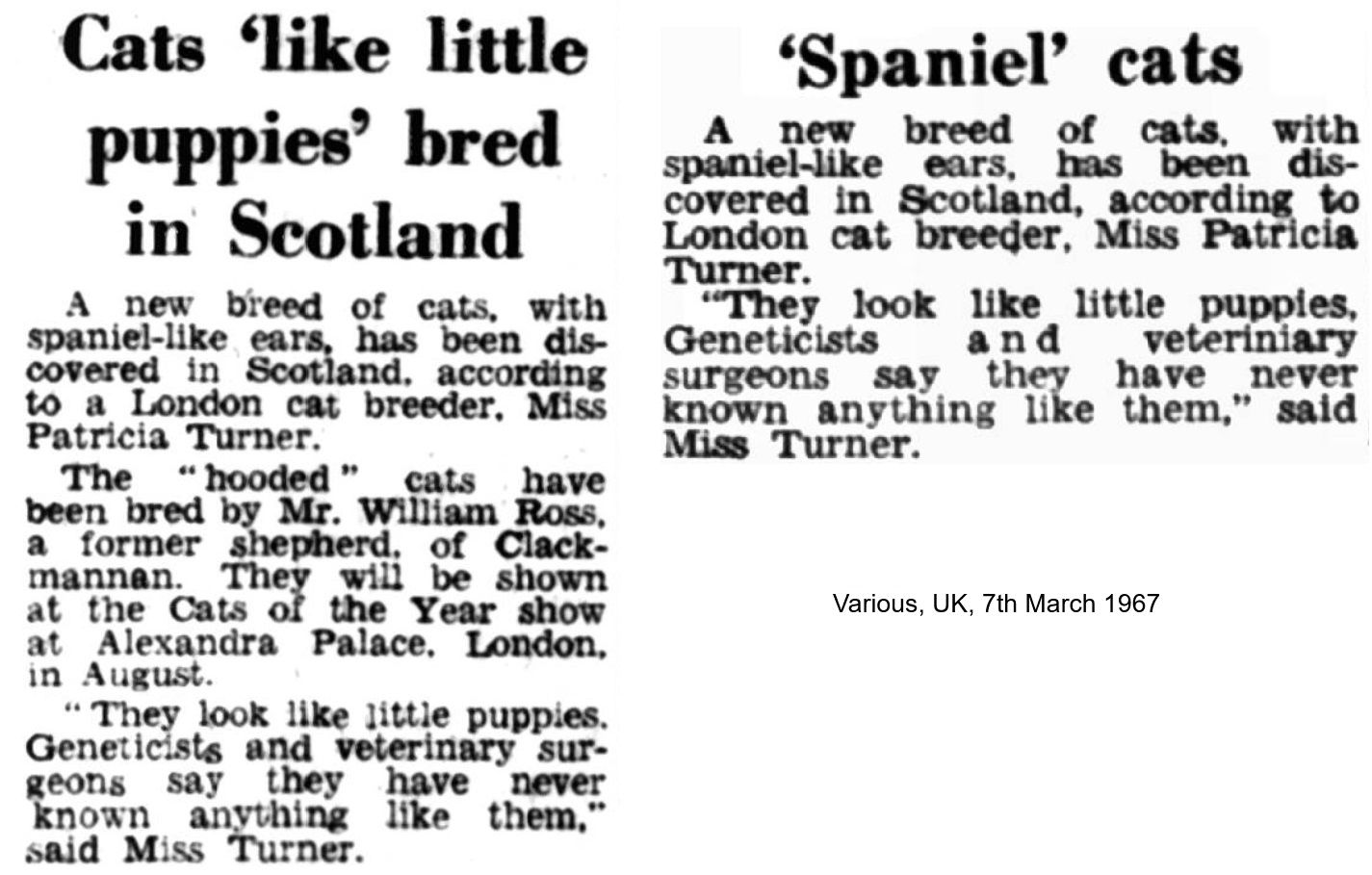
The only widely recognised fold-eared cat is the Scottish Fold and its longhaired version, the Highland Fold (Coupari). These have ears which form a close-lying cap. Also known as Scottish Lop, the Scottish Fold traces back to a female white shorthair farm kitten discovered near Coupar Angus, Perthshire, Scotland in 1961. This cat, Susie, produced some fold-eared kittens. One of these, Snooks, became the founding mother of the breed after Susie's unfortunate death in 1963. By 1967, numerous "Lop-eared Cats" had been born however the UK cat registries declared the trait to be a deformity and refused to accept the "Scottish Fold" for breed status because of potential ear problems (an inconsistency considering they recognised the tailless Manx). Interest in Scottish Folds in the USA led to breeding being continued there and it was recognised as a breed in 1973. The cat does not suffer undue ear problems and one British registry accepted it in 1983. The Coupari wass the name given to Longhair Folds in the UK, although these are known elsewhere as Highland Folds. The argument is that Coupar Angus is not in the Highlands, however Highland Fold is no more inaccurate than other breed names e.g. Balinese, Tonkinese. Longhaired cats were present in the original Scottish Fold, but the shorthaired variety was preferred because the ear shape was more visible. It was developed in the 1980s and recognised in 1986. It is known by various names: Coupari (in UK), Highland Fold, Longhair Fold and Scottish Fold Longhair.
Kittens are born prick-eared and start to develop the folding at around 4 weeks old. The fold is fully developed at around 3 months of age. The gene causing the folded ear trait is a dominant gene which causes skeletal problems if the cat inherits two copies of the gene. Scottish Folds are therefore always bred to prick-eared to keep the incidence of problems to a minimum. The problems are a thickened tail caused by tail vertebrae fusing and thickened legs with swollen feet due to overgrowth of cartilage around the paws. These side-effects cause problems with walking.
Prick-eared Scottish Folds gave rise to the Scottish Shorthair in Australia. This breed (with longer tail and legs, and different coat texture to the British Shorthair) was recognized and named by the Queensland Independent Cat Council (QICC) as a result of a submission by Rona Sandilands at a meeting at then QICC-president Pat Mercer s home attended by prominent Scottish Fold and British breeders, including Lillian Carter founding breeder in Queensland. The first Scottish Shorthair exhibited was Ptah Dunstan Gold, bred by Lillian Carter and owned by Rona Sandilands. During the 1980s he was exhibited at the Queensland Longhair Cat Club show, achieving a Reserve in Group 3 under Victorian Judge Marie Orchard. There is also a Scottish Longhair.
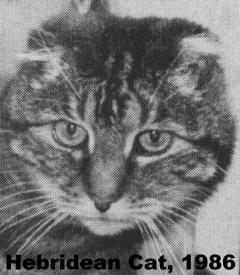
Cats With Folded Ears (Scottish mutation followed by a German occurrence) - Rosemarie Wolff: 'A new mutation of the "cat with folded ears" was found in Germany (Bavaria) in spring 1971. Ten years after the first lop-eared cat cropped up at a farm in Scotland (later they were made officially known as "Scottish cats with folded ears" or "Scottish folds" for short) the second mutation turned Up in Dachau near Munich/Bavaria (Hangeohren). Miss Patricia Turner helped us to import the first "Folded-ears-cat" to Germany, a very sweet tempered brown Tabby male "Scintilla Tommilop" [. . . ] Now we have from him the first litter of "Scottish folds" on the European continent, all of them brown tabbies, three folded-eared, one prick-eared. But the real sensation brought an article in a Munich Boulevard paper "Die Abendzeitung" with Tommi's picture. Several people telephoned to tell us of a stray cat in Dachau, about 30 miles from Munich, with exactly the same ears as Tommilops. Though at first we doubted the truth of this information, L. Schwarz and I drove at once to this little town, equipped with a big photograph of Tommi. With the trial and error method we actually succeeded in finding this stray male cat, called "Sepp", who seemed to be a sort of well-known cat-character and a shy personality roaming in the vast riverside and big wild orchards of Dachau. He was living free and on his own kept alive by eating mice and rats and occasional scraps of food from some cat-loving people; however he was often chased and threatened by others. We found a family living there in a big house and garden, owning two female cats occasionally courted by "Sepp," who agreed to feed him regularly from now on. By and by he became tamer and we succeeded in taking a photo, still from afar, but at least proving his existence. We now hope soon to capture him for good and to integrate him into the cattery of L. Schwarz. With such an old experienced chap this will not be an easy task. But perhaps we will succeed and then also be able to establish a Bavarian line of "Folded-ears." '
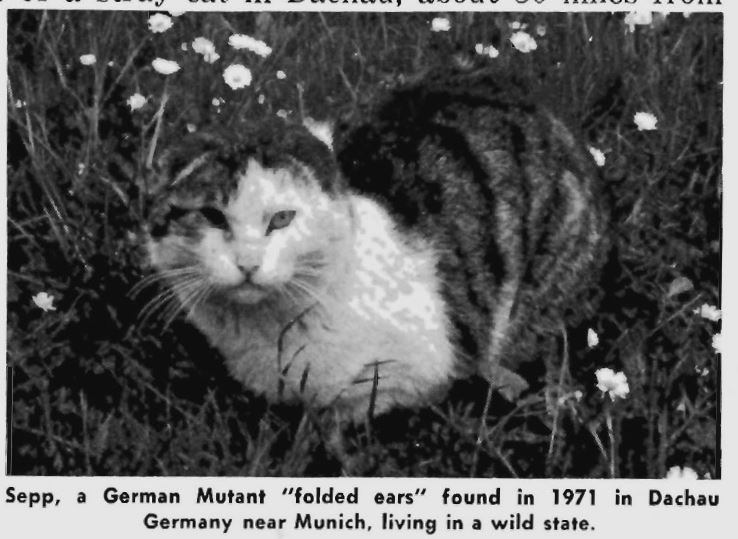
The Poodle Cat (Pudelkatze) is essentially a breed developed from the Scottish Fold and Devon Rex to create a curly coated fold-eared cat - a curly-coated Scottish Fold or fold-eared Devon Rex. It was developed initially in Germany where its future is threatened by rulings prohibiting the breeding of cats with harmful defects. This ruling affects Scottish Fold cats because of the skeletal abnormalities which can occur. The breed is attractive and if breeders are careful to breed only from healthy cats, there is no reason it should not be accepted. Astonishingly, there appears to be the intention of adding Manx into the mix so that the cats are tailless as well. This would create a more dangerous mix of semi-lethal genes since the Manx condition can cause other skeletal abnormalities.
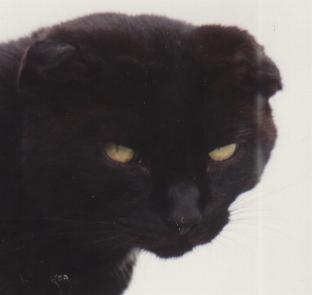
Back in 1981, Phyllis Lauder wrote in "The British, European and American Shorthair Cat" wrote of news from Australia of "interference not beneficial to the domestic shorthairs". A correspondent, Mrs Batten, had been asked for her views on the idea of crossing Manx with Scottish Folds. Scottish Folds had not yet been recognised. Lauder wrote that the idea was born of "love of change for its own sake and by the desire to meddle" since a Manx/Fold cross would not only produce a freakish-looking cat, it would be a tragedy for the cats - the two breeds had enough to contend with in refuting charges of deformity.
The unrecognised Oriental Fold is a Siamese/Oriental type cat with folded ears (I believe it came from attempts to breed colourpoint Scottish Folds). The Hemingway Fold is an unrecognised variety of fold-eared cat with extra toes. The term "Hemingway" is often used in America to describe polydactyl cats (mitten cats). It results either from a spontaneous folded ear mutation in a polydactyl cat or from accidental or deliberate crossed of Scottish Folds and polydactyls, possibly for curiosity or as attractive pets.

A fold-eared cat aiming for recognition is the Foldex or Exotic Fold. The Foldex is a cat of Exotic (shorthaired Persian) body type developed through crossing Scottish Folds with Exotics. It has a shorter nose than the Scottish Fold but not as short as the Exotic Shorthair. In other respects it is a fold-eared version of the Exotic Shorthair. Facially, the Foldex looks like "a little furry owl". Like the Scottish Fold, it is prone to the same bone deformities and produces some non-folded offspring.
In 2005, the Ukrainian Levkoy Cat, a fold-eared naked cat, was created using the Don Sphinx and Scottish Fold. The Ukrainian Levkoy is less extreme in body and face type than the Don Sphinx (the face is wider and ronder) and the ears do not fold tightly to the skull as in the Scottish Fold, but stand out from the head and fold closer to the tips. It also occurs in velour and prick-eared forms.
In 1986 there was a report of a "Hebridean Cat". The owner said that the tiny ears were a feature of Hebridean and in addition the ears were folded like those of a Scottish Fold. No more was heard of the Hebridean breed.
In the mid-1990s, a fold-eared black cat turned up in a feral cat colony in Essex, England. It was not possible to determine whether the trait was inherited or was a birth defect. It is extremely unlikely to be due to a free-ranging Scottish Fold as these are uncommon in Britain - there would certainly be no free-ranging unneutered Scottish Fold males around.
In 2007, Vasilis Lekkas from Athens (who is deeply involved in the recently formed Greek network for the preservation of domestic livestock including cats) reported possible folded ears on the Greek island of Myconos, but these may have been due to injury.
Lizzie Ellis (The Feline Rescue Association Inc, Maryland, USA) provided this photo of a folded ear apparently caused by frostbite. The ears had to be surgically removed. This shows how inury, including haematoma ("cauliflower" or collapsed ears from fighting) and frostbite can mimic folded ears at a casual glance.
And also quite recently, according to fellow cat historian Amanda Bright, folded-ear cats appeared on Ile Madame in Nova Scotia, but after the colony was culled the mutation was lost.
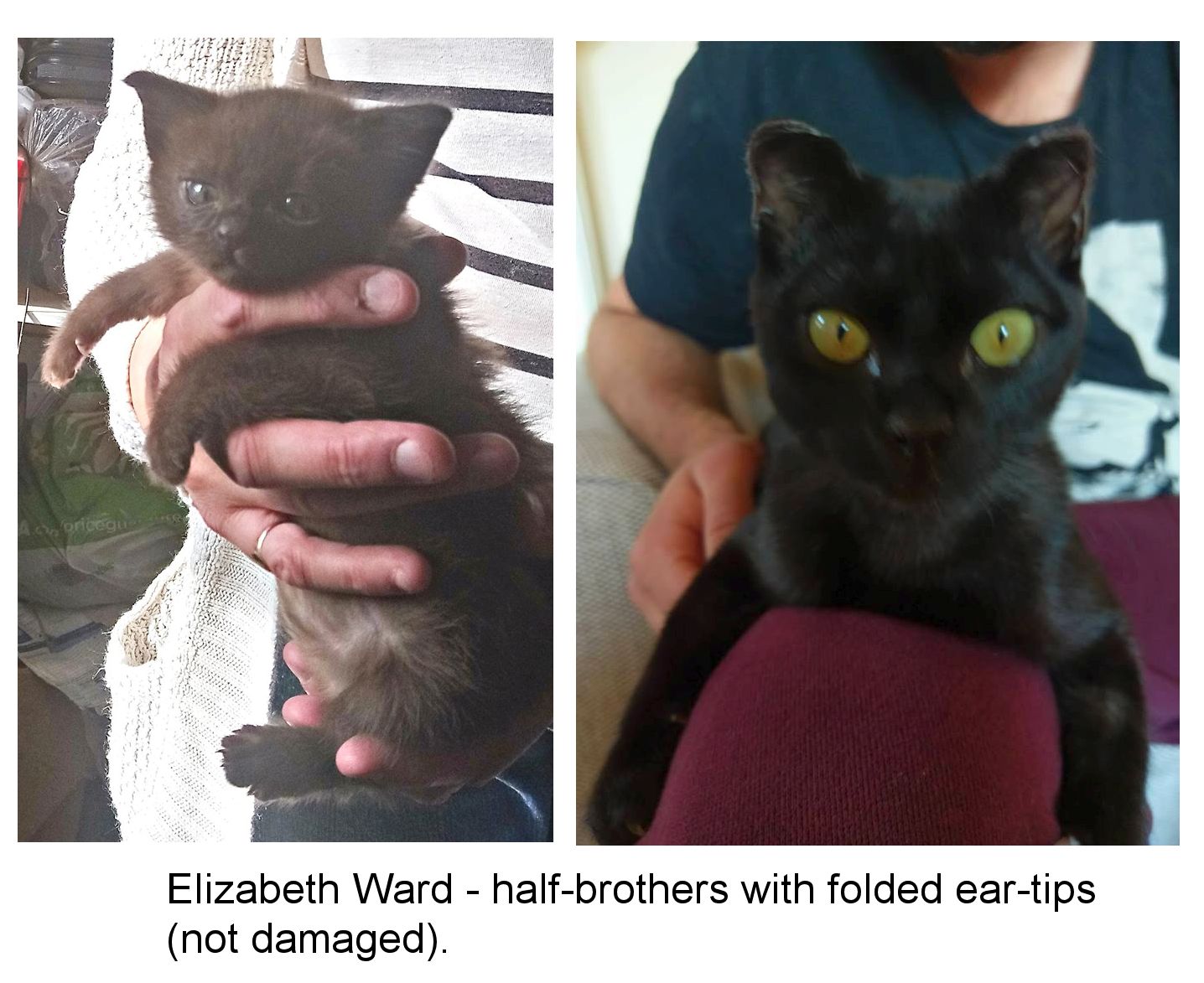
Elizabeth Ward, Wales, in July 2017 This is a nine month old cat. The ears amaze me. They remained folded over as they are with very young kittens until he was perhaps three or four months old and this is as far as they have opened up. There has never been any injury or frostbite to them. It is beginning to look genetic. Although nowhere near as extreme, here is his half-brother, aged eight weeks. Look at the right ear. Actually both ears are like this, it's just easier to see on the picture on his right ear.
Interestingly, in 2001 a man in Texas took beach strays, selecting and breeding them for rounded ears and panther-like looks. Unfortunately after he died his family disposed of the cats, splitting up the breeding stock. He referred to them as "Panthurettes" and in September 2001 only one stud cat, Panthur, remained, but was likely to be neutered due to a lack of interest in the trait.
CURL-EARED CATS
The first recognised curl-eared breed was the American Curl. The ears are curled or swept back on themselves and feel rigid to the touch. The originate from a stray kitten, Shulamith, in 1981. Shulamith was a black longhair female with strangely curled ears. She went on to produce kittens, some of which also had curled ears. These attracted attention when shown at a cat show in 1983 and in 1985/6 the American Curl breed was recognised.
The mutation is a dominant gene so litters will often contain a mix of curl-eared and prick-eared cats. It is impossible to tell which kittens will develop a good curl - they are all born prick eared. The ears curl up tightly over the next few days. During the next four months, the tight curl starts to relax until the final semi-curled state is reached. As far as is known, the gene does not cause detrimental side-effects.
The Hemingway Curl is a localised variety rather than a breed. The first Hemingway Curl appeared as a spontaneous curl-eared mutation in a colony of polydactyl cats known as Hemingway cats (after the polydactyl cats of Ernest Hemingway) on Key West. Hemingway Curls have since been crossed with African Jungle cat hybrids to produce the Jungle Curl breed. It occurs in shorthair and longhair versions and may attract sufficient interest for a breed to be established.
Having established the curl-eared trait, it became possible to cross American Curls with other breeds to create new varieties e.g. the Kinkalow which is a mix of American Curl and Munchkin to produce a short-legged curl-eared cat.
The Ruffle was, according to one source, an accidental side-effect resulting from attempts to improve the ear size of American Curls by introducing the Cornish Rex into a breeding line. Whether the Cornish Rex is an allowable outcross for the American Curl is another matter entirely. According to another source, the original mating was a deliberate attempt to produce a new breed. Progeny from this breeding line was apparently acquired by a breeder unaware of the Curl-to-Rex matings which had the side-effect of introducing the recessive gene for curled fur. The gene remained hidden until two carriers were mated and produced curly coated American Curls some generations later. The rippled effect of the fur reminded the breeder of a brand of potato snack hence the name Ruffle. Unfortunately the breeder's circumstances changed and further development of the Ruffle breed could not be funded. Interestingly, the Rex coatd in American Curls was mentioned as early as 1991 by feline geneticist.
An experimental breed called the Jaguarundi Curl (shorthaired and longhaired) was reported in 2001, but its existence is unconfirmed. The Jaguarundi is a South American felid which is very un-cat-like in shape. It is suspected that the reporter had confused it with the Jungle Curl. The Jungle Curl does exist and is a hybrid of Jungle Cat (F chaus) and American Curl or Hemingway Curl with Serengetis, Jungle cat hybrids, pure Jungle Cats, Bengals, Egyptian Maus, Abyssinians and other domestic shorthairs contributing their genes to the mix. It is still in the developmental stage to produce wild looking cats, preferably with a spotted or rosetted pattern, with curled ears. Several breeders in Illinois are working with a curl-eared polydactyl cat called Impians (formerly called Tulips). Impians were originally developed in the 1990s by crossing American Curls with polydactyls, creating a harlequin patterned semi-longhaired breed. The markings, which can be any colour, are restricted to the head, down the spine, shoulders, hips and tail.
The Australian Curl was a breed that never was, rather it was a single female cat, Matilda, which was discovered in 1996 and who failed to pass on the trait. The curl of the ears apparently differed from that of the American Curl though no precise details were provided. She was mated to a normal eared cat of similar type, but none of the kittens were curl-eared. She suffered severe illness after the birth (1997) and could not be bred from again. No back-crossing could be attempted to determine whether the gene was carried as a recessive. Although none of the offspring had curled ears, they were not bred to each other (or it was not possible to do so) to determine whether they carried the trait was carried in recessive form. It is possible that a breed opportunity has been missed due to Matilda's unfortunate illness.
In 2007, Vasilis Lekkas from Athens (who is deeply involved in the recently formed Greek network for the preservation of domestic livestock including cats) reported "In the islands of Paxoi in the Ioania Sea in western Greece, an otherwise conventional cat with curled ears is common. Locals consider it their "normal" cat and view as unusual cats of the mainland or other islands. These cats tend to be white bodied with restricted coloured patches. It appears the mutation may be similar to American Curl. There are two Paxoi islands, but is unclear, which one the report relates to." A young cat with a moderate curl has also been reported.
The Elf breed was initiated in 2006 with the first full hairless, curl-eared Elf being born in 2008. It combines the Sphynx hairlessness with the American Curl's ear conformation. Permissible out-crosses include non-pedigree domestic shorthairs. They have a sturdy, athletic build, are sociable, intelligent, inquisitive and people centred. Half-Elf cats e.g. furred Elf variants result from outcrosses to diversify the gene pool.
The Dwelf also combines curl ears with hairlessness, but adds Munchkin and Highlander (a bobtailed, curl-eared polydactyl breed) to the mix. These combine hairlessness, curled ears and short legs. Non-standard (long legged) Dwelfs may resemble the Elf breed.
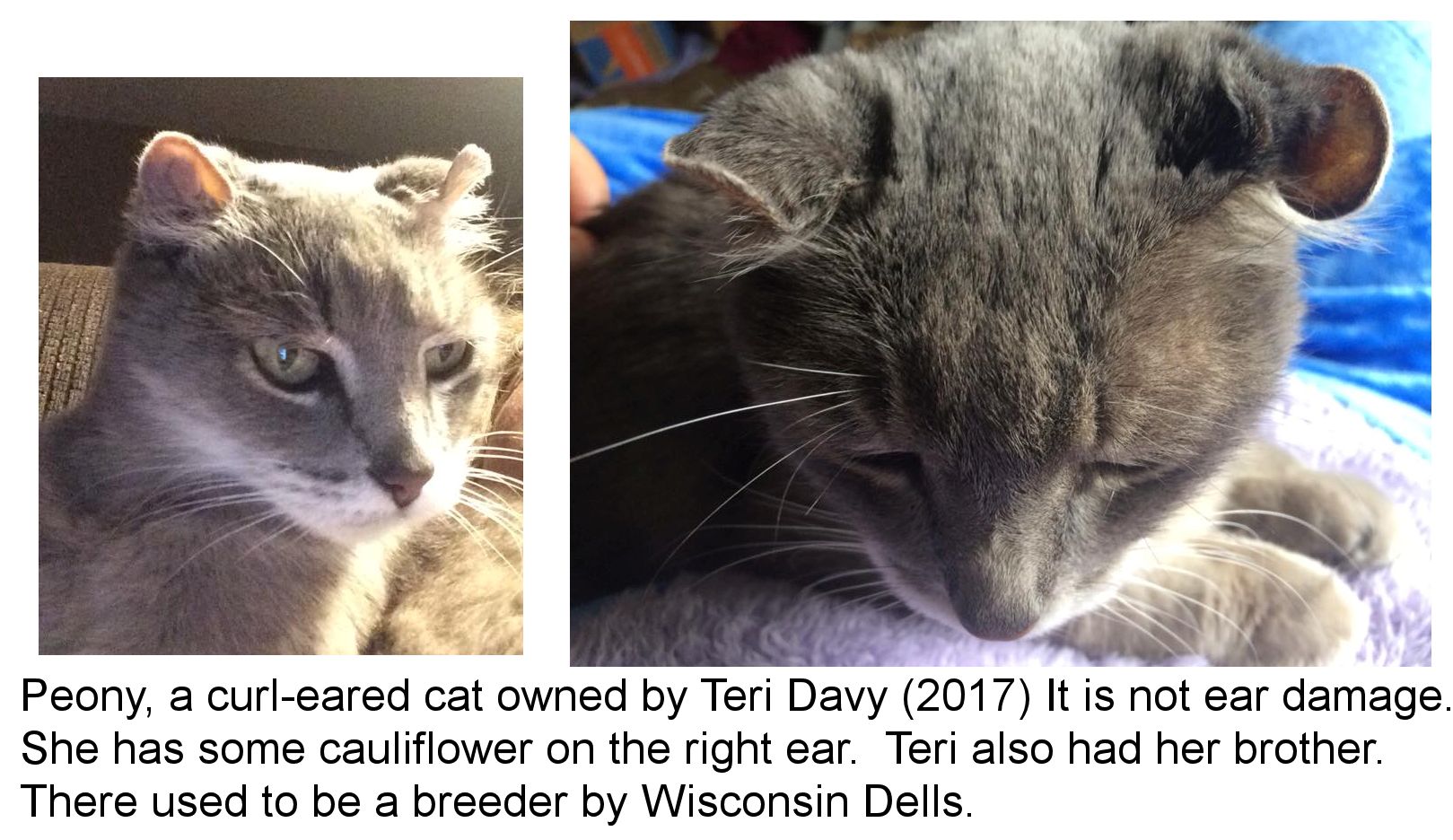
The Arctic Curl was a proposed curl-eared cat that was ultimately never developed. In the early 2000s, it was proposed to be a cross of Turkish Angora and Selkirk Rex, with the possible addition of Balinese later. The aim was a blue-eyed white curl-eared cat resembling the Turkish Angora with a curly semi-long coat, no woolly undercoat, and slightly rounder eye. Other Turkish Angora colours would occur because dominant white masks other colours. In addition, blue-eyed white is strongly linked to deafness. In 2018, the would-be breeder, Penny O'Dell [or Odell] (Tremarie Persians and Selkirk Rex) was banned for life from owning, keeping or looking after any animals due to a cat hoarding situation. 73 cats, mostly unneuted, unkempt and interbreeding, were kept in squalid conditions and some had to be put down.
CURL X FOLD CROSS
This cross is highly discouraged because of the bone problems found in Scottish Folds, but the kittens below show how the genes interact. The ears are folded sharply backwards. it is as though the curl gene reverses the fold direction.
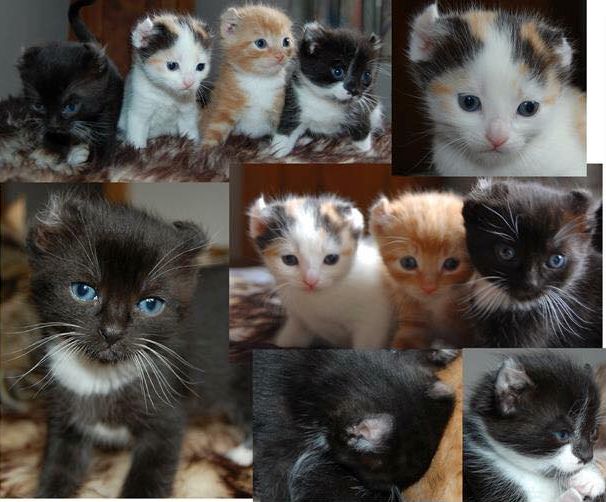
UNUSUAL CURLED EARs
Kuchisake Onna from Brunei Darussalam provided these photos of an unusual curl-eared kitten adopted in 2016. The skull shape is also a bit unusual and might indicate a chromosome abnormality. The parents are both domestic shorthairs with normal ears. None of the littermates have the curled ear shape.

And these photos from Jelena Nekrasova also show an unusual ear shape.

IRISH SHORT-EARED CAT
Described in a light-hearted book depicting cats which had been "painted" with vegetable dye (in fact all painted cats were photo-manipulations), the Irish Shortear is a mutant-eared cat that never was. This footnote has been included because people have asked where to find an Irish Shortear!
The book in question was the spoof "Why Paint Cats" and the fake breed among genuine breeds was the Irish Shortear. It was described as Burmilla x Scottish Fold with large protuberant eyes, short ears and very relaxed nature due its excellent vision. The photo was that of a Brown Burmilla which was been edited to give the cat larger eyes, narrower chin and short ears (the original ear tip had been photographically enlarged and grafted back onto the face). The face was then grafted back onto the image of the cat's body. One giveaway was that the facial area had a "floating effect", which is common in photo-composites. A Scottish Fold would have given folded not shortened ears. In addition, the partial-dominant "macro-retinal" gene mentioned in the text is fictional (and it should have been a macropthalmia gene since the retina is the back of the inside of the eye).